
Ro-Ro traffic between Spain and Morocco is recording strong growth, linked to the development of agri-food exports but also to increasing integration with the European economy. The relocation of industrial production centres will give a boost to maritime traffic in the coming years.
With two seaboards (Atlantic and Mediterranean), more than 8,000 kilometres of coastline, and the existence of two archipelagos (Balearic and Canary Islands), Spain occupies a unique place among the European nations in terms of short sea shipping (SSS). According to Eurostat data, it ranks 3rd in Europe, with 211 Mt transported in 2020, behind Italy (287 Mt) and the Netherlands (283 Mt). France comes in 4th position with 160 Mt.
New perspectives with nearshoring
At a meeting held on November 24 in Madrid to celebrate the 20th anniversary of SPC-Spain, the Spanish association for the promotion of short sea shipping, the president of the shipping company Baleària, Adolfo Utor, launched into a passionate plea on North Africa's potential, “from Mauritania to Egypt”. According to him, the Covid-19 pandemic has accelerated a process of relocation of industrial activities that will continue and generate new flows.
The disruptions in global supply chains triggered by the Covid-19 pandemic have indeed accelerated the desire to bring part of the production sites closer to end customers, in order to minimise risks. To serve the European market, this movement of nearshoring opens up prospects for North Africa, and in particular Morocco. This area has two essential advantages: geographical proximity to Europe and low wage costs. Relocation is a topic studied by Spanish think-tanks [1] and a clear priority for Spanish diplomacy [2].
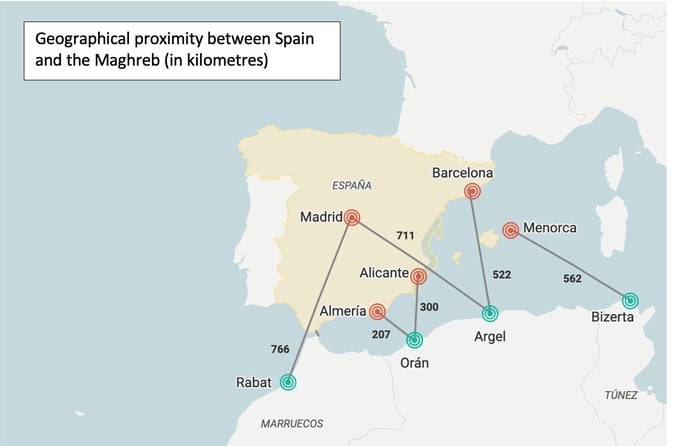
Source : CIDOB
Ro-Ro traffic in short sea shipping could prove successful in attracting these new flows, as it offers significant advantages: availability of lanes, regularity of schedules, absence of port handling, reduction of CO2 emissions, etc. It appears to be a transport solution that is both reliable and low-carbon, two fundamental requirements of shippers. At the SPC-Spain meeting, Alvaro Rodríguez Dapena, president of Puertos del Estado, the public body that oversees Spanish commercial ports, mentioned a beginning of a “transfer” from containers to Ro-Ro in Spain-North Africa traffic.
For the Spanish shipowners, who have missed the boat of traffic between Spain and Italy, the Peninsula-Morocco traffic, in particular, offers the opportunity to position themselves strongly on a market with great potential for growth and to try to outmanoeuvre the offensive of the Italian companies present in the peninsula.
International Ro-Ro traffic growth
In the recent past, international short sea shipping, that is to say excluding cabotage, has experienced a strong growth in Spain as it rose from 154 Mt in 2010 to 218 Mt in 2019 (+41.5%), according to statistics published by the Spanish Association for the promotion of the SSS, SPC-Spain [3]. The COVID-19 pandemic caused a decline to 198 Mt in 2020 but the year 2021 was characterised by a recovery (219 Mt, +10.3%) which continued during the 1st half of 2022, although at a slower pace (+3.4%). Unloading is higher than loading (58.9% and 41.1% respectively in 2021).
Bulk (dry and liquid) account for the vast majority of traffic: 121.1 Mt or 55.4% in 2021. Then there are containerised goods (57.4 Mt, 26.2%), Ro-Ro traffic (28.2 Mt, 12.9%) and conventional transport (12 Mt, 5.5%).
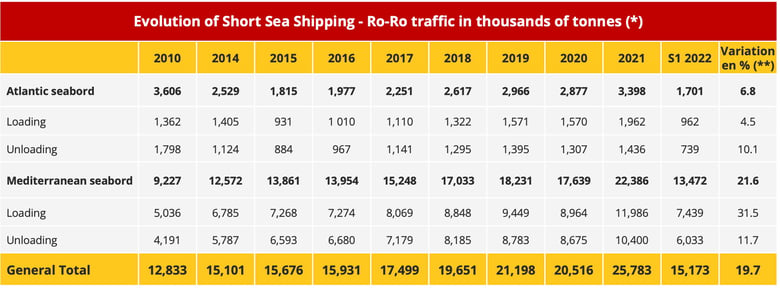
(*) Excluding new vehicles. (**) 1st semester of 2022 compared to 1st semester of 2021 - Source: SPC-Spain.
The Ro-Ro traffic component, excluding new vehicles, is characterised by its dynamism:
- Between 2010 and 2021, traffic increased from 12.8 Mt in 2010 to 25.8 Mt in 2021, a doubling in the space of 11 years. The recent figures are particularly significant since after a decrease of 3.2% in 2020, linked to Covid-19, the year 2021 was characterised by a clear recovery (+25.7%) which continued during the 1st half of 2022 (+19.7%).
- This increase is explained by the strong expansion in traffic on the Mediterranean seaboard (+142% between 2010 and 2021) which comprises the vast majority of traffic (22.4 Mt, or 87% of the total in 2021). On the Atlantic seaboard, traffic has generally declined, from 3.6 Mt in 2010 to 3 Mt in 2019, the year before the outbreak of the pandemic. However, 2021 was marked by a clear recovery (+18.1%, 3.4 Mt) which continued during the first half of 2022 (+6.8%).
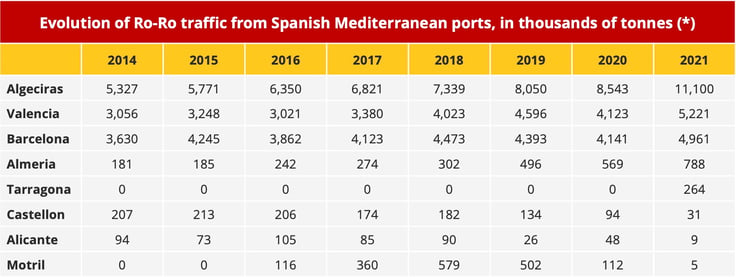
(*) Excluding new vehicles - Source: SPC-Spain.
A remarkable development in the Mediterranean
In the Mediterranean, the distances between Spanish ports and those of Italy and North Africa are short, which has made it possible to densify the number of lanes and make the activity profitable. Added to this is the volume of passenger traffic, mainly linked to tourist trips but also, as a specific element of this area, to the movements of Maghrebian populations emigrating to Europe and Europeans of Maghrebian origin. Hence the existence of a fleet consisting of pure Ro-Ro ships and passenger/freight ferries (Ropax).
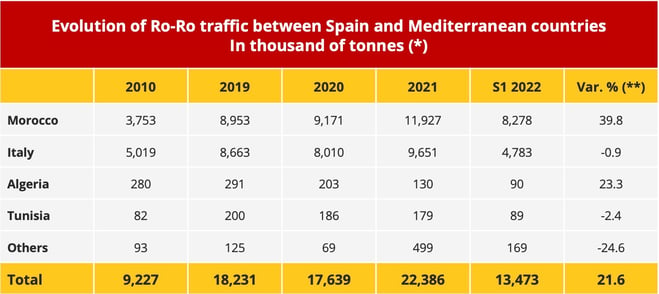
(*) Excluding new vehicles. (**) 1st semester of 2022 compared to 1st semester of 2021 - Source: SPC-Spain.
The analysis of traffic in the Mediterranean by destination shows interesting developments:
- Initially, flows were boosted by the development of lanes between Spain and Italy under the aegis of Italian shipowners, led by Grimaldi. While the pandemic caused a decline in 2020, a clear recovery occurred in 2021 (+20.1%, 9.6 Mt), but it was not confirmed during the 1st semester of 2022 (-0.9%). This stagnation should not mask the consolidation of traffic and especially the success achieved in terms of modal shift and environmental impact. According to SPC-Spain, in 2020, SSS captured 53.1% of international transport demand (excluding rail traffic) between Spain and Italy. As a result of a partnership with Grimaldi, more than half of the goods moving between Amazon's stores in Spain and Italy are transported by ship.
- The new development is the emergence of Morocco which became the number one destination in 2016 and has retained this rank since that date. Recently, there has been a real “take-off” of traffic with an increase of 30% in 2021 (11.9 Mt), which accelerated further in the first half of 2022 (+39.8%). According to SPC-Spain, the increase was similar in the second half of last year.
- Other North African countries are lagging far behind. Their figures are much more modest and were in decline in 2021: Algeria (-36.1%) and Tunisia (-3.5%).
A specific Hispano-Moroccan dynamic
The growth in traffic with Morocco can be explained first of all by the steady increase in trade with Spain over the past 10 years. Total trade (exports + imports) rose from €9 billion in 2013 to €16.8 billion in 2021 (+86.6%). This dynamic continued in 2022 with an increase in exports of 27.7% during the first ten months (+21.2% for imports). Trade with Algeria followed a reverse trajectory with a decline between 2013 (€13.2 billion) and 2021 (€6.7 billion). Figures for 2022 (over 10 months) show a 36% drop in exports.
The Spanish-Moroccan dynamic is fuelled by the economic growth of the southernmost of the 2 neighbours but also by the flow of exports of agricultural products (fruits and vegetables). Added to this is the effect of the industrialisation of Morocco around Tangier Med (automotive in particular) and the development of new integration schemes. An example of this is the Inditex group (Zara, etc.) which sends fabrics to Morocco and re-imports manufactured products. These dynamics are not seen in the relationship with Algeria, a country handicapped by its business environment (despite the recent relaxation of the legal framework for foreign investment) and the absence of a real strategy of industrial and commercial openness.
High concentration of Spanish port traffic with North Africa
The port of Algeciras concentrates most of the traffic with Morocco: 11.1 Mt in 2021, or 93% of traffic from Spanish ports in the Mediterranean. The number of heavy goods vehicles (trucks, trailers and tractor-trailer units) crossing the Strait of Gibraltar, mainly on the Tangier Med- Algeciras maritime corridor, increased from 252,000 vehicles in 2013 to 463,000 vehicles in 2022 and is expected to reach the 600,000 mark in 2025.
Given its geographical proximity, the port of Almeria is well positioned and registered a traffic of 0.7 Mt in 2021. Then there are the ports of Barcelona (159,000 t) and Valencia (38,000 t).
Traffic with Algeria remains modest, with only Almeria showing a significant figure (105,000 t in 2021). As for Tunisia, Barcelona is clearly top of the leader board with 122,000 t.
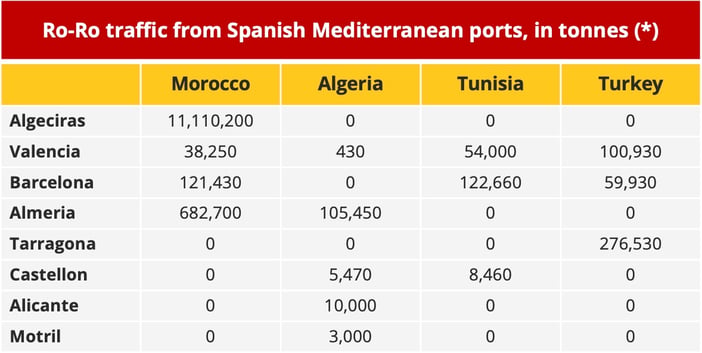
(*) Excluding new vehicles - Source: SPC-Spain.
Supply situation in development
The gap between the two seaboards also appears in the available supply for road freight transport (RFT):
- In the Mediterranean, it increased overall by 66% between the first half of 2012 and the first half of 2022 to reach 2.5 million linear m2.
- On the Atlantic coast, the increase was less (+22%) and stands at slightly above the million m2.
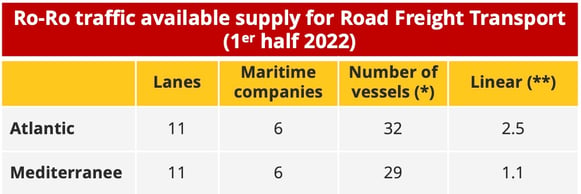
(*) Ro-Ro and Ropax. (**) Millions of m2 - Source: SPC-Spain.
As for the maritime highways (3 departures per week in each direction at least), the two seaboards have the same number of lanes (4) but offer different capacities.

(*) Ro-Ro and Ropax. (**) Millions of m2 - Source: SPC-Spain.
However, these figures are constantly changing in view of the renewed interest of Spanish shipowners. Last November, the company Baleària announced the establishment of a new daily Ropax lane between Motril (Andalusia) and Tanger Med with the Volcán de Tauce (1,100 linear metres). It thus strengthens its offer to Morocco, a country in which it has been present since 2003 with 7 daily rotations between Algeciras and the Moroccan port, as well as the Almeria-Nador and Sète-Nador lanes launched in 2020.
The evaluation made by the company itself testifies to its potential. During the first month of operations, half a thousand trucks were transported. The Andalusian port benefits in particular from its geographical location and the quality of the communication infrastructure. The distance from Madrid, via the motorway network, is 443 km compared to 661 km from Algeciras.
Armas Trasmediterranea, for its part, has started transporting trucks between Motril and Al Hoceima: for the moment these carry food products. The Italian company GNV, which belongs to the MSC group, may be considering opening a lane to Morocco from Valencia while several ports in southern Spain want to develop traffic with the overseas neighbour. Morocco is “on the radar”, especially of Barcelona and Valencia.
Favourable winds
The dynamic Ro-Ro traffic is expected to continue over the next few years due to a combination of factors. The development of economic and trade relations between Morocco and Europe is a serious trend, which the relocation, at least partial, of industrial activities of European companies that will further accentuate it. Several recent surveys and studies have shown the willingness of companies to diversify their suppliers and “shorten” their supply chains, especially for the production of essential or strategic goods. Morocco is not the only country close to Europe that could take advantage of this opportunity: other countries in North Africa or Eastern Europe are also waiting in the wings. But the Cherifian kingdom has real advantages in this area.
Spain, due to its strategic location and historical relationship with Morocco, plays a key role in this new context. The dynamic in Ro-Ro traffic between the two countries will only increase in the future because it has proven its competitiveness.
[1] “Spain and the Maghreb: neighbourhood, nearshoring and the post-pandemic”
[2] "Estrategia de Accion Exterior 2021 2024"
[3] The figures in this article are taken from the Short Sea Shipping Observatory published by the SPC-Spain Association.
Daniel Solano
Business journalist
Our latest articles
-
Subscriber 2 min 19/12/2025Lire l'article -
Container shipping in 2025
Lire l'article -
Air cargo: the rerouting of flows is confirmed
Lire l'article


